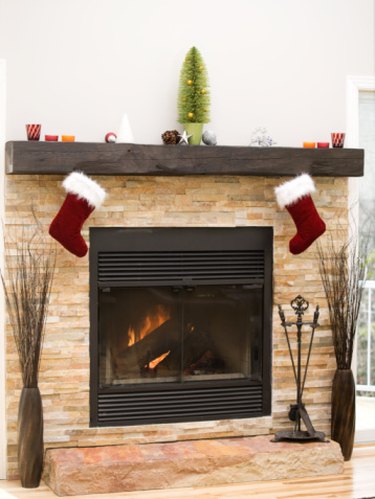Things You'll Need
Mantle beam
Tape measure
Pencil
Level
2-by-4-inch board
Drill
2 1/2-inch concrete screws
3-inch deck screws (optional)

Rustic fireplace styles often look good with a beam-style mantle shelf. A mantle shelf is a mantle that doesn't have support legs or even visible support brackets. In many cases the mantle looks like it is embedded into the wall or supported by the brick or stone of the fireplace surround. In reality, most mantle shelves or beams are installed over wood cleats that are mounted to the wall. In most cases this type of installation takes only a few minutes.
Step 1
Measure the width of your fireplace surround. The surround is the non-combustible material facing the fireplace. A surround is often 12-to-18-inches wide and it surrounds the fire box. Measure the available width of your mantle if the fireplace has windows or built-in cabinets close on each side. Your mantle should be wider than the surround but not more than 6-to-8-inches on each side.
Video of the Day
Step 2
Determine the height of the mantle based on your wall proportions. Cut out a piece of cardboard the size of your mantle and tape it to the wall at varying heights. Many fireplaces have a mantle between 1/3 to 1/2 the height of the wall. If you have tall walls the mantle should be positioned as it relates to the fireplace, not to the wall height. Usually you can find a good location by experimenting with your cardboard pattern. Mark the height.
Step 3
Center the mantle over the fire box at the height you desire. Use a level to make sure the mantle is level. Trace around the perimeter of the mantle on the wall with a pencil. You will use this outline as a guide when installing the beam.
Step 4
Turn your beam face down. On the back side you should see that the mantle beam is hollow. Cut a 2 by 4-inch board the width of this hollow. This board is called a cleat. Measure from each end of the mantle to where the hollow area starts and transfer this measurement to the wall. Measure down the thickness of the wood above the hollow and mark this on the wall. This shows you the location of the cleat.
Step 5
Position and center the cleat within your marks. If you are screwing into a brick wall, drill a pilot hole into the 2-by-4-inch board and screw a 21/2-inch concrete screw through the flat 4-inch side of the board and into the brick. Do not screw into the mortar as the brick will be stronger. If you are screwing into drywall, use a 3-inch decking screw. Keep your cleat level and screw additional screws every 12 inches along the cleat.
Step 6
Position the beam so that it fits over the cleat and lines up with the wall tracing. Make the beam snug to the wall. Screw through the top of the beam 1-inch away from the wall in the area of the cleat. The screw should be long enough to go through the top of the beam and 1-inch into the cleat. Screw every 12-inches.
Step 7
Apply caulk along the cracks between the beam and the wall. Fill any screw holes with wood fill.
Tip
Some walls are very irregular and you may need to scribe and cut the beam to conform to stones or other materials. Solid beams should be hollowed out to fit the cleat. There are quick ways to do this using a table saw and chisel.
Video of the Day